Apple's 15-inch Core i5 MacBook Pro: The One to Get?
by Anand Lal Shimpi on April 14, 2010 10:38 PM EST- Posted in
- Mac
- MacBook Pro
- Arrandale
- Core i5
- Laptops
They’re Actually Faster
Benchmarking under OS X isn’t difficult, you just need to get creative. Luckily I’m in dire need of creative outlets so creating OS X benchmarks works for me. I’m using the same tests I introduced in my Holiday 2009 Macbook Pro roundup and running on the same hardware (specs listed in the tables on the previous pages). The Core i5 system is the new entry level 15-inch MacBook Pro.
We’ll start with general application performance.
General OS usage is a difficult thing to quantify, but one measure of performance has always been the number of bounces an icon in the dock makes before an application loads. I decided to take it to the next level and write a quick script to launch 15 applications in a row, timing how long the entire process takes.
I launched, in order: Mail, Safari, Activity Monitor, iTunes, iCal, DVD Player, iPhoto, Photo Booth, Quicktime Player, Disk Utility, Preview, iMovie, Front Row, Garage Band and Aperture.
The entire process stresses both the disk and CPU, which is why we see a huge improvement when going to an SSD as well as differences between CPU speeds.
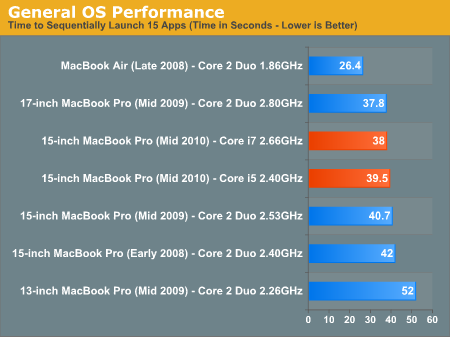
My application launch test absolutely rocks on the MacBook Air because it ships with an SSD by default. The MacBook Pros are stuck with mechanical hard drives and thus don’t perform nearly as well. If you’re curious, installing an Intel X25-M G2 in any of the MBPs will drop their times to 16 seconds or less.
The new MacBook Pro also doesn’t improve performance that much. I measured a 3% increase in performance, which although repeatable, isn’t really spectacular. This is compared to the old 2.53GHz Core 2 Duo and should serve as a baseline for the minimum performance improvement you should see. In other words, the 2.4GHz 15-inch MacBook Pro should perform no worse than last year’s 2.53GHz model.
The $2199 model with a Core i7 running at 2.66GHz pushes performance up another 3.9% over the base model. That's actually more than I expected but the real strength of the i7 is visible in the more CPU bound tests.
Adobe Photoshop CS4 Performance
The Retouch Artists Speed Test we use for our CPU testing under Windows also works under OS X. We're running the exact same benchmark here, basically performing a bunch of image manipulations and filters and timing the entire process.
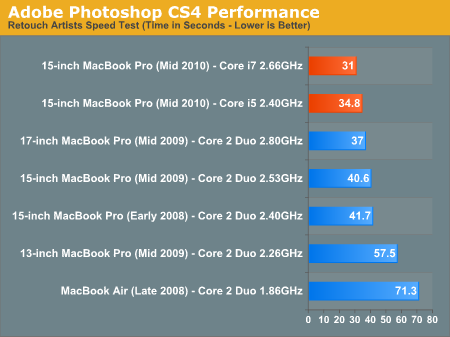
The old 13-inch MacBook Pro is penalized by only shipping with 2GB of memory, which is why it performs so poorly here. The real comparison is between the 2.4GHz Core i5 vs. the 2.53GHz Core 2 Duo from last year. The former is 16.6% faster in our Photoshop test. In fact, the new 15-inch MacBook Pro is even faster than the older 2.80GHz 17-inch model I reviewed.
The Core i7 model is 12.3% faster than the baseline Core i5 2.40GHz. Definitely noticeable.
Aperture 2 RAW Import
For my Aperture test I simply timed how long it took to import 203 12MP RAW images into the library.
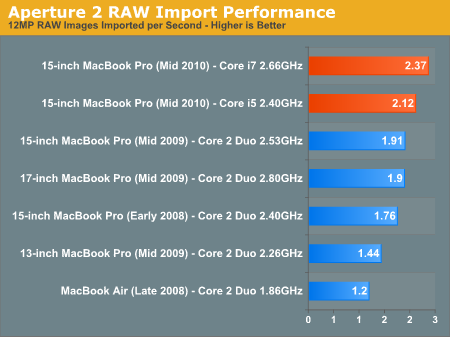
The new entry level 15-inch MBP is 10.9% faster than the old MacBook Pro, and again, it’s faster than the old 17-inch model as well. Moving to the Core i7 gives you another 11.8%.
Cinebench R10
I’m a fan of the Cinebench test because it lets me show off both single and multithreaded performance in the same workload. First, the single threaded performance:
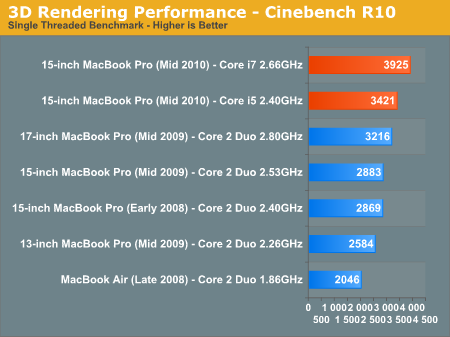
Here we have a huge advantage on the new MacBook Pro. Intel’s Turbo Boost is active here, resulting in a large performance advantage, not to mention all of the enhancements present in the Nehalem/Arrandale architectures. This is one of the best situations for the Core i7 vs. the i5. The extra $400 gives you another 14.7%, not bad at all.
Multithreaded performance is equally impressive:
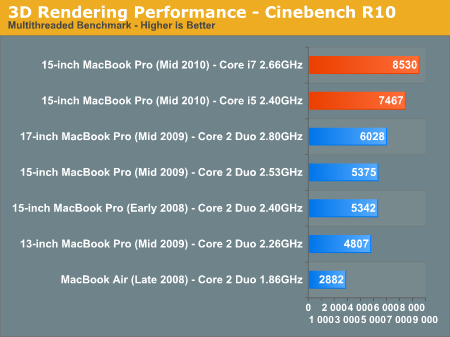
Thanks to Hyper Threading, the new Core i5 puts a generational gap between itself and last year’s MacBook Pro in this test. Whether you’re running single threaded or multithreaded applications, the Core i5 can be noticeably faster than the Core 2 Duo.
Quicktime H.264 Video Encoding
Our final benchmark is more consumer focused. Here I'm taking an XviD and converting it to an iPhone-supported H.264 format.
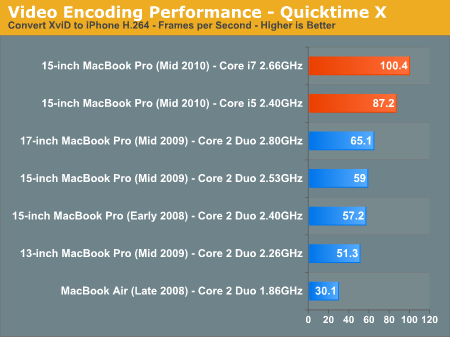
Video encoding is one of the i5’s definite strengths. If you do a lot of video encoding on your notebook, the jump from Core 2 to i5 is tremendous - approaching 50% in this case even despite the “lower” default clock speed. This is also the best showing for the Core i7 - count on an extra 15% over the base Core i5.
Core i7 vs. Core i5 Performance Summary
The two Core i5 models Apple offers ship with a 2.40GHz or 2.53GHz processor, both with a 3MB L3 cache. The $2199 15-inch MacBook Pro comes with a 2.66GHz Core i7, with a full 4MB L3 cache. Compared to the entry level model that's an 11% increase in clock speed and a 33% increase in L3 cache.
While I don't believe there's much reason to go for the 2.53GHz over the 2.40GHz model (L3 cache size remains the same, clock speed goes up by a small amount), the Core i7 is actually pretty decent. For a 22% increase in total system cost you end up with 11 - 15% better performance in CPU bound applications. It actually even feels snappier in general use as well.
I'd still suggest opting for an SSD before considering any CPU upgrades, but if you're looking to keep your new MacBook Pro for a while the Core i7 is worth it.










114 Comments
View All Comments
mckirkus - Thursday, April 15, 2010 - link
I have a feeling a lot of the people that use these make movies which requires bulk storage. Even a 256GB SSD would tack on at least $500Pneumothorax - Thursday, April 15, 2010 - link
As being one of those poor saps that "upgraded" to the previous gen MBP and realized I can only run my Intel 160gb G2 reliably at SATA I speeds, this new laptop makes me wary of going for another round of disappointment... So is it fixed?webdev511 - Thursday, April 15, 2010 - link
Envy 15 hasa better GPU ATI 5830
better top end CPU i7 820m
higher ram capacity 16GB
7200 RPM drives standard Dual SSD available
I had high hopes for this rev of MBP, but suffice to say, I'm unimpressed.
flyguyjake - Friday, April 16, 2010 - link
1) Is the display refresh rate 60hz, or 120hz?2) What is the contrast/dynamic contrast ratio?
I phoned Apple today 3x and couldn't get the answers from them. I did however get the following information.
I'm told that if I install boot camp / Win 7 w/USB Blu-Ray drive I can get 1080P on the LCD panel. BUT what's even more exciting is that the MiniDisplay port, via HDMI Griffin adapter, will fully support 1080P video & DTS-HD, TrueHD audio bistream. The i7-620M has PVAP 1.5 (protected video audio path) which is needed for the HD audio & the 330M is HDCP compliant.
What is even MORE exciting is the possibility of 3D !!! The Geforce 330M supports Nvidia 3D vision.
Can this setup play Blu-Ray 3D?
Can this all really be true?
prof.yustaz - Friday, April 16, 2010 - link
Anand Lal Shimpi,"The day has finally come. For nearly a year now I’ve been telling everyone who wanted a new MacBook Pro to wait for Arrandale."
Right. But at the end of the review you also said this: "With a Core i5 and GeForce GT 330M, the new MacBook Pro can get uncomfortably warm under use. I found that the previous generation unibody ran cooler. Intel expects to see Arrandale power consumption go down sometime after the middle of the year with a future rev of the processor. I'm guessing that's what'll be used in the inevitable Fall update to the new MacBook Pro lineup."
Are you saying that Apple will do another refresh in about 5 months just because Intel will release another rev of the CPU? And if that happens, do you expect to see a meaningful reduction of heat and perhaps an even better battery performance? In other words, is it really worth the wait?
"You're paying for the design, build quality and ultimately the right to use OS X. If those things don't matter to you (particularly the OS X item) then you'd be much better off with an ASUS or Dell."
Those things do matter to me, a lot, minus the OS X. But I do not see being much better off with an ASUS or Dell precisely because those things matter to me. Grinding my teeth, I would be willing to sacrifice Apple's design and build quality for function, but ASUS, Dell, HP or Sony do not offer the same battery life and screen resolution as Apple's 15 inch laptop. Am I missing something here? And isn't it true that somewhat comparables offerings from Dell and HP, for example, run even hotter than the most recent Apple's 15 inch laptop?
"If you're curious about what's next, I have two words for you: Sandy Bridge. Due out sometime in Q1 2011, Sandy Bridge looks incredible based on early performance data. No word on when we'll see it in notebooks but if you like torturing yourself, waiting for Sandy Bridge will pay off."
I need a laptop, but I do not have to have it right now. Plus, I do not want to pay over $2,000 for a laptop now if it is going to be blown away in a year or so. Could you please elaborate a little on what can we expect to see in terms of design and function assuming Apple implements Sandy Bridge in a future rev of MBPs? Will they be thinner? Will they have a significantly better battery life and run a lot cooler?
P.S. Also, if you were to purchase the current 15 inch MBP, which combination of the CPU, Memory and HD would you choose to stay below $3,000 (closer to $2,500).
Thank you.
lparsons - Sunday, June 20, 2010 - link
"ASUS, Dell, HP or Sony do not offer the same battery life and screen resolution as Apple's 15 inch laptop."I have to agree with you here. I've been looking around a lot, and while the MBP is expensive, Apple has put together an excellent set of components. They make good choices wrt battery life and performance tradeoffs. The closest thing I can find is the Thinkpad T510 which is a very solid machine, but lacking in 3D graphics performance and I'm not keen on the 16:9 screen. It doesn't have quite the same build quality (though it's still very good) and the batter life isn't quite as good, in part due to the lack of switchable graphics.
I'm hoping to keep the machine for while, so the i7 seems to make sense. Annoyed that the 4GB is 2x2GB, making a future upgrade more expensive than necessary, so I'm debating the 8GB. Would also love an SSD, but I'm thinking that I'll upgrade to that later when the price (hopefully) drops, since I could really use the capacity of the 500GB drive and the Apple SSDs are extremely expensive. Also, the Hi-Res screen is a must for me.
ihouman - Friday, April 16, 2010 - link
Anand, I read this article yesterday and your conclusion between the i5 and i7 were slightly different, as were a few other points. If you had a change of heart, you should append the changes to the end as opposed to removing your original opinion. It creates the image that 'someone' helped persuade your new opinion.Anand Lal Shimpi - Friday, April 16, 2010 - link
Since the original publication I got my hands on a Core i7 based 15-inch model. While I expected the clock speed/cache increase to only result in a less-than-10% performance increase, it ended up doing more than that. It's based on this data (and only this data) that I updated the conclusion, I will edit the conclusion to reflect that this change was made however :)Take care,
Anand
Apolloe - Friday, April 16, 2010 - link
Am I right in assuming that your Left 4 Dead and World of Warcraft tests were done with the i5 15", and not the i7? I assumed this since your info on the GPU there had 256MB, while the i7 MBP has 512MB.If so, any chance of showing the fps results from these games? If not, an answer to the above would be suffice :)
cyrexo - Friday, April 16, 2010 - link
Thanks for the nice review. Could you please measure the battery life with the i7 also?the heat difference between i7 and i5 would also be a nice information which could help me with my decision^